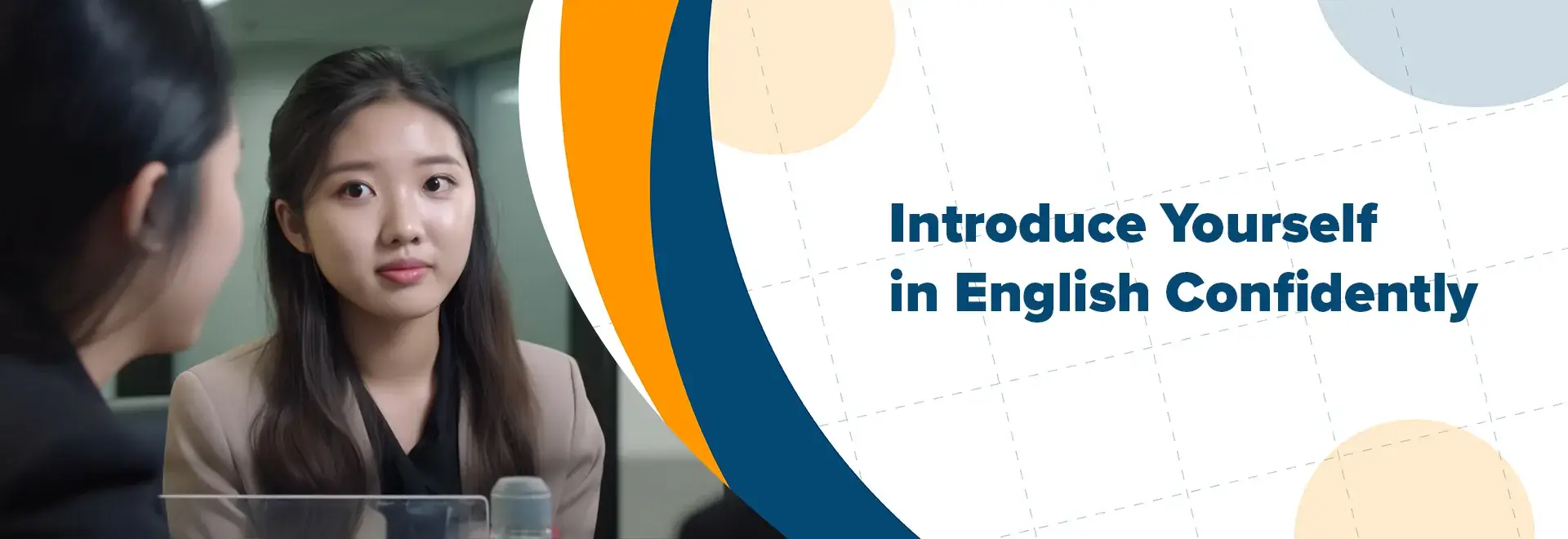
Introduce Yourself in English Confidently: 10 Effective Ways and Examples
Introduction
Confidently introducing yourself in English is an essential skill for effective communication. Whether you are meeting new people, attending interviews, or networking, a strong self-introduction leaves a lasting impression.
You must know some tips to effectively and confidently introduce yourself in English. Whether you are a beginner or a pro in English, you must have an idea of how effective self-introduction matters when meeting new people and in other similar situations.
How do you introduce yourself in English? What are specific pieces of information that should be included in your self-introduction? In what situations do you introduce yourself in English? We will answer these questions in this article. Just keep on reading.
The Elements of an Impactful Self-introduction
It is important to think about things and aspects when you are planning to introduce yourself in English to your audience. It is not an easy task, but you have to do your best to leave a lasting impression on your audience.
Crafting a captivating self-introduction is a crucial skill that can open doors to various opportunities. Whether you are attending a job interview, networking event, or social gathering, an effective self-introduction can leave a lasting impression and pave the way for meaningful connections.
Before diving into creating your self-introduction, it’s essential to consider the audience you will be addressing. Making your introduction resonate with your specific audience can significantly enhance its impact. Are you addressing professionals in a formal setting, or engaging with peers in a casual environment? Understanding your audience will help you shape your self-introduction accordingly.


Here are some things to ponder to introduce yourself in English with an impact:
- Concise and Impactful Opening
Begin to introduce yourself in English with a concise and impactful opening that grabs the attention of your audience. Consider using a rhetorical question or a compelling statement to pique curiosity and draw your listeners in.
Other speakers, when they are invited to talk at a particular event (e.g. workshops or trainings), they start their self-introduction with a quote. This way, they can easily get the attention of their audience.
- Personal Introduction
Share relevant personal details that provide insight into who you are. This could include your name, profession, or a brief overview of your background. Keep it concise and focus on aspects that are relevant to the context in which you are introducing yourself.
There is no need to say unnecessary information when you introduce yourself in English especially when it does not fit the situation. Just be in context.
- Highlight Achievements or Expertise
If suitable for the setting, consider highlighting a key achievement or expertise that showcases your value. This could be a professional accomplishment, a unique skill, or an area of expertise that sets you apart.
You can also share a sample scenario where you achieved something, even little things.
- Clear Call to Action
Conclude your self-introduction with a clear call to action that aligns with your overarching goal. Whether it’s expressing your eagerness to connect further, offering your assistance, or sharing your contact details, a clear call to action sets the stage for future interactions.
Crafting a compelling self-introduction is a blend of art and strategy. It requires a deep understanding of your audience, a keen awareness of your strengths, and the ability to articulate these aspects concisely and engagingly. Master how to introduce yourself in English so you can seize opportunities and make meaningful connections that can propel your personal and professional growth.
Example Situations to Introduce Yourself in English Confidently
When it comes to introducing yourself, it’s important to be prepared for different scenarios that you may encounter in your personal and professional life. Here are some sample situations where self-introduction plays a crucial role.
- Networking Events
At networking events, you have the opportunity to connect with new people who share similar professional interests. Your self-introduction should be concise yet impactful, giving others a clear understanding of who you are and what you do.
For example, “Hi, I’m [Your Name]. I specialize in digital marketing and have a passion for creating engaging content that drives results.”
- Job Interviews
During a job interview, your self-introduction sets the tone for the conversation. It’s essential to highlight your relevant skills and experiences. Sometimes, while looking at your impressive cover letter and resume, the interviewer asks you to tell them about yourself and obviously, you start by stating your name.
For instance, “Good morning, I’m [Your Name]. With five years of project management experience, I’ve successfully led diverse teams and delivered complex projects within tight deadlines.”
Focus on the relevant information specifically for the position you are applying for. Remember that it is always better to introduce yourself in English with enthusiasm and confidence as you highlight your achievements, experiences, and qualifications.
- Social Gatherings
When meeting new people at social gatherings, a friendly and approachable self-introduction can help break the ice.
You might say, “Hey there, I’m [Your Name]. I love traveling, and I’m always on the lookout for new culinary adventures. What about you?”
This could mean that the way you introduce yourself in English sets the atmosphere of the situation and the initiation of small talk.
- Professional Conferences
At professional conferences, you’ll be interacting with industry peers and potential collaborators. Your self-introduction should convey your expertise and interests.
For example, “Hello, I’m [Your Name]. I’m a data analyst with a keen interest in leveraging analytics to drive business growth and innovation.”
- Business Meetings
In a business meeting, where you’ll be engaging with colleagues and clients, a confident and articulate self-introduction can establish your credibility.
You could say, “Good afternoon everyone. I’m [Your Name], and I specialize in developing strategic partnerships that deliver value and drive sustainable growth for our clients.”
- Volunteer Activities
When participating in volunteer activities, a warm and genuine self-introduction can foster a sense of community and shared purpose.
For instance, “Hi, I’m [Your Name], and I’m thrilled to be part of this initiative. I’m passionate about environmental sustainability and excited to contribute to our efforts.”
In each of these example situations, a well-crafted self-introduction can make a lasting impression and create opportunities for meaningful connections. By focusing your introduction on a specific context and audience, you can effectively communicate your identity, interests, and aspirations.
Effective Ways to Introduce Yourself in English Confidently
Here are 10 effective ways and examples to help you master the art of confidently introducing yourself in English.
- Start with a Greeting
Begin your introduction with a friendly greeting such as “Hello,” “Hi,” or “Hey.” This sets a positive tone and makes the other person feel welcome.
- State Your Name and Background
When you introduce yourself in English, clearly state your name and provide relevant background information including the name of the university you graduated from, your highest achievement awards, or any relevant skills you have.
For example, “Hi, I’m Thomas Sanders. I am a recent graduate of Cambridge University, where I majored in International Relations. I graduated with Latin Honors.”
- Express Your Enthusiasm
Express enthusiasm about the opportunity to introduce yourself. Show genuine interest in the conversation by using phrases like “I’m excited to be here” or “It’s a pleasure to meet you.”
- Highlight Your Skills and Experience
Briefly highlight your skills and experience that are relevant to the situation.
For instance, “I have extensive experience in digital marketing and social media management, and I’m passionate about creating impactful online campaigns.”
- Share a Personal Anecdote
Connect with your audience by sharing a relevant personal anecdote. This creates a memorable and relatable introduction. For example, “I recently traveled to Japan and discovered a passion for Japanese culture and language.”
To catch the attention of your audience, your anecdote must make them laugh.
- Use Positive Adjectives to Describe Yourself
Employ positive adjectives to describe yourself, such as “enthusiastic,” “dedicated,” “creative,” or “reliable.” This helps to shape a positive impression in the minds of your listeners.
- Engage in Small Talk
Engage in light small talk by asking simple questions or offering compliments. This helps to build rapport and establish a comfortable atmosphere.
Some people start with small talk before they formally introduce themselves. It is one way to connect with the person you are introducing yourself to. Usually, this happens in casual conversations.
- Offer a Conversation Starter
End your introduction with a conversation starter, such as “I’d love to hear about your experience with [relevant topic].” This invites the other person to engage in the conversation. If you introduce yourself in English with a conversation starter, you will be able to speak comfortably with the person you are talking to.
- Practice Active Listening
Be an active listener during the conversation. Show genuine interest in the other person’s responses and maintain eye contact to demonstrate attentiveness. This way, your interlocutor will feel comfortable and at ease.
- Conclude with a Positive Closing
End your introduction with a positive closing, such as “It was great meeting you,” or “I look forward to connecting with you further.” Other people also say “I hope to see you again next time,” or “See you soon.” It means that you want to meet them again or you want to be more connected with them. This leaves a lasting impression of confidence and professionalism.

Insights
Introducing yourself in English is a valuable skill that can leave a lasting impression. It is not easy, especially if it’s your first time, but it’s better to be confident when introducing yourself to easily build connections and establish social interactions.
How do you introduce yourself in your own language? Share it with us here.



